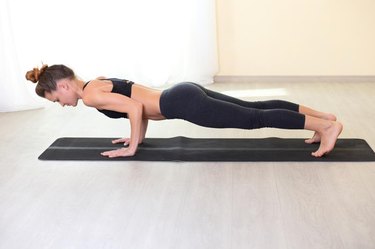
Six-pack abs might come at a steep cost. If you're practicing the wrong ab exercises, or over-stressing your abdominal muscles, you could be doing more harm than good. Avoid the negative side effects of ab exercises with a carefully selected workout routine, and by paying close attention to your body — pain is a signal telling you something's wrong.
Strained Muscles
Video of the Day
It's possible to overwork the network of muscles that make up your abdominals and core. Just like any other muscle group, your abs are subject to strain if you overexercise, perform an activity your body isn't ready for, lift something heavy or sharply twist your body while playing sports.
Video of the Day
If you're experiencing muscle pain, soreness, swelling, bruising, stiffness, or problems flexing your abs, take a break from exercising and apply ice. If the soreness persists longer than a day or two or you experience extreme pain, it's time to visit a doctor or physiotherapist.

Back Pain
When you're performing an ab exercise like a crunch or sit-up, you could be setting yourself up for a painful back injury. Stuart McGill, a back-pain clinician and professor of spine biomechanics at the University of Waterloo in Canada, warns that these exercises place a "devastating load" on the discs of your spine.
McGill's lab found that the load placed on the spine, combined with the flexing motion of a sit-up caused discs to bulge and eventually herniate -- a serious back injury. These conventional ab exercises are quickly falling out of fashion; exercise physiologists and personal trainers are starting to replace these staple exercises with less injury-prone alternatives.

Pain-Free Exercises
There are many ab exercises, like those that draw from yoga, that match the natural mechanics of your body, leaving you pain-free. McGill suggests exercises that focus on held positions, like the plank.
His suggestion is mirrored by Commander David Peterson, executive officer for the physical education department at the U.S. Naval Academy. Peterson also recommends the plank, since holding a static position mimics how we use our core in daily life while pushing, pulling, and carrying.
Static Exercises
Static exercises like the plank are the path to pain-free abs. To execute a proper plank, lay flat on your stomach and lift your body off the ground using your hands and feet, and hold this push-up position for as long as you can.
The plank engages your core in a way that mimics the static, held position you'll need to lift a heavy object, so it builds muscle in a way you can actually use. The plank is a good gateway into other static exercises like the side plank, the bird dog and the bent-leg raise.
You can work your way up to a whole routine of challenging ab exercises. If your muscles begin to shake, it's a good time for a break — overexercise can strain your ab muscles.
Read more: The 41 Hardest Ab Exercises
Warning
If you think you may have injured yourself while exercising, discontinue exercise and see a doctor immediately.